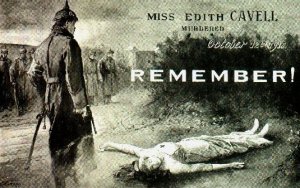WW1 Anti-German Propaganda
This image was frequently used during World War I as anti-German propaganda; the postcard depicts the execution of a British Nurse, Edith Cavell, by the German army in 1915.
After Cavell’s death, in the following months and years, there were endless newspaper articles, pamphlets, images, and books that publicized her story. She quickly became an iconic propaganda figure for military recruitment in Britain to help increase favorable American sentiment towards the allies.
Cavell became such a popular icon because of her sex, her nursing profession, and her apparently heroic approach to death. In the image shown her execution is represented as an act of German barbarism and moral corruption.
Because of the British government’s decision to use her story as propaganda, Cavell became the most prominent British female casualty of World War I. The combination of heroic appeal and a significant act of violence narrative made Cavell’s case one of the most effective in British propaganda of World War I.
This image of propaganda appeals to fear and emotion of the viewers. The British government built support by instilling anxieties and panic in the general population, by depicting the brutal intentions and actions of the German government, specifically towards a woman nurse.
Also another technique used is black and white fallacy, meaning there are only two choices, either you side with us or the enemy. Although the only words in this image say “Miss Edith Cavell, murdered, remember” because of her story there only leaves two sides, you feel sympathy and side with the Brits, or you are for the German side, making yourself the enemy.
Another type of technique I found was the bandwagon technique, with the attempt to persuade the target audience to join in and take the course of action that “everyone else is taking”. This form of propaganda is very specific and not normally used today with a certain individuals murder as the poster child for a stance, but it was very effective in the overall mission of getting people to join alongside the British military.

Leave a comment